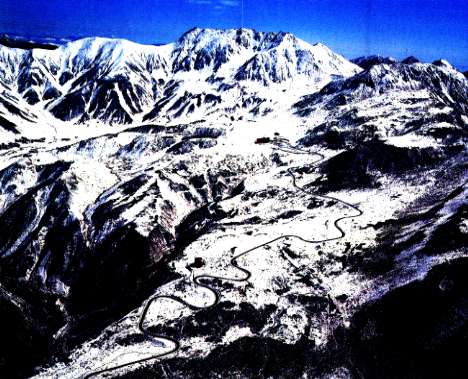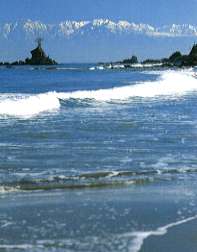
Mountains, Snow And Greenery
Toyama Prefecture, situated in the central part of Honshu(the main island of Japan), facing north on the coast of the Sea of Japan, is a region of relatively compact size, which, as it happens, is about one percent of the whole country's total area. With high mountains in the east and vast plains in the middle extending to the west, and several large rivers flowing through the plains, Toyama Prefecture has a variety of geographical features and scenic spots. The fertile plains yields rich-flavored rice and other farm produce including tulip bulbs, Toyama Bay, embraced by the land, supplies the people with a wealth of fresh fish and other kinds of seafood.

Beautiful tulip flowers
The climate is relatively moderate with four distinct seasons, but occasionally it snows a lot. Snow, however, is a plentiful source of water, and an abundant water supply produces hydroelectricity. Snow also helped shape the people's character by giving them patience and perseverance. Interestingly, snowfall in Toyama is said to have a kind of cyclical pattern: extremely heavy snow seems to fall every 18 years. To cite one recent instance, the snowfall in January, 1963, which measured more than 6 feet on the ground, was followed in 1981 by another heavy snowfall, which lay more than 5 feet deep. We are wondering what will happen in 1999. For a long time snow used to be something for people to combat against. However, in recent years, there arose a new awareness that snow could be brought under control or even be utilized somehow in more positive and effective ways.
Another natural feature that characterizes Toyama Prefecture is the fact that the degree of natural vegetation is one of the highests in Japan. (probably just after Hokkaido and Okinawa) This means that the Prefecture has more unspoiled greenery than any other part of the main island. The flora of the Prefecture is rich and varied with about 2,500 kinds of plants growing on plains and mountain areas. The abundance of plants and trees around us is certainly our most precious natural assets.
Tateyama And Kurobe

Peaks of Tateyama and the bus line from Bijodaira to Murodo
When it comes to mentioning some outstanding scenic spots in Toyama Prefecture, Tateyama and Kurobe immediately come to mind. Undoubtedly, the Tateyama Mountain Range with its soaring 10,000-foot-high peaks is one of the best-known natural beauties in Toyama Prefecture. The Tateyama Mountain Range makes up an integral part of the "Japan Alps" often referred to as the "Roof of Japan". The snow-capped Range seen against the background of blue, bright sky in early winter is really breath-taking and awe-inspiring. Kurobe Gorge, the deepest and largest in Japan, streches along the Kurobe River with its steep and craggy precipices, displaying spectacular natural wonders. Far up the River is Kurobe Dam, one of the vantage points in the Tateyama Kurobe Alpine Route, which connects Toyama City to Omachi City, Nagano Prefecture, with the Japan Alps in-between. The route is closed under deep snow in winter. It reopens in April, and the bus line between Bijodaira and Murodo in springtime is a thrilling experience on the road with very high ice walls on both sides. At some points the ice walls are more than 40 feet high. A growing number of tourists visit Tateyama and Kurobe every year to enjoy the splendid beauty of the area.
Tourism And Ecology
 Amabarashi Beach and Tateyama
Amabarashi Beach and Tateyama
Firefly squids mysteriously emanating blue light near the shore around Namerikawa,mirages which project fantastic images on the horizon far off the shore around Uozu, snow grouse and Japanese antelopes inhabiting the Tateyama Mountain Range, (incidentally, the snow grouse is designated as the Prefectural Bird), the geological wonder of the "Buried Forest" in Uozu are some of the other natural attractions the people in Toyama are proud of.
Tourism is playing a major role in the regional economy today. However, as the saying goes, ecology is more important than economy. It is our responsibility to preserve and protect our magnificent natural environment for the generations to come.